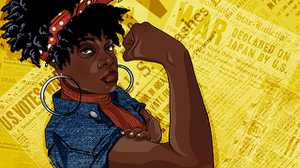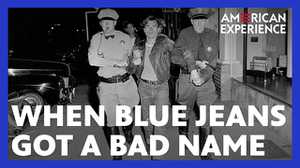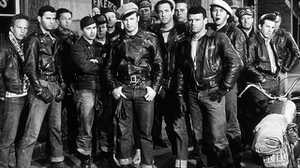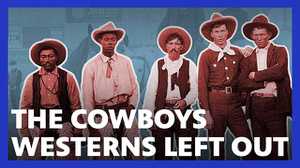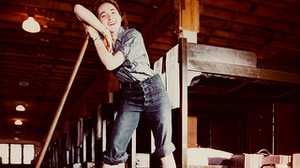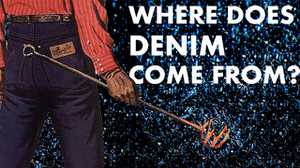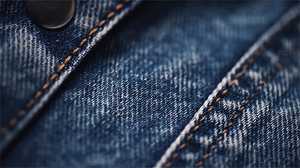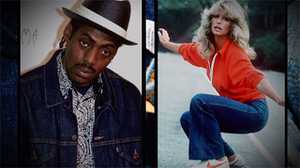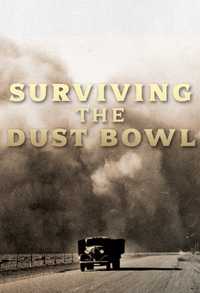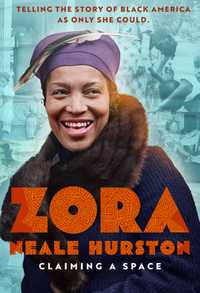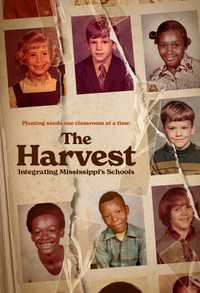James Sullivan, Author: You don't really stop and think about why half of the population of the planet is wearing them on any given day. We just are.
Melissa Leventon, Curator: Have you ever asked yourself why everyone you know owns multiple pairs of jeans?
Jonathan Square, Fashion Historian: Dress it up, dress it down..
Tommy Hilfiger, Designer: People know when they wear them they look cool.
Emma McClendon, Fashion Historian: This one garment can be both universal and individual at the same time. There’s nothing like that in the history of clothing.
Valerie Steele, Fashion Historian: And in fact, Yves Saint Laurent said he wished he had invented jeans, that he thought they were the most important item of fashion in the 20th century.
SOT: They wore them in the mines, on the cattle trails.. My own father wore them toppling 200ft Douglas firs…
Melissa Leventon, Curator: Jeans are the quintessential American garment.
SOT: 120 years later gentleman blue jeans are still basically the same pair of pants..they came out of the California gold rush
Stephen Aron, Historian: But so much of the story we tell about jeans is a myth.
SOT: The strongest pants the west has ever seen
Tanisha Ford, Historian: It's one that is about the cowboys, and the west, it's about Levi Strauss, and the Gold Rush--
Emma Mcclendon, Fashion Historian: It’s always the same story. . .
Emma Mcclendon, Fashion Historian: After the cowboys, jeans got picked up by rockers and bikers and hippies and now everybody wears them. But denim has been around much, much longer. It has a long and deep history with so many other fascinating stories that are not always told.
SOT: Levi’s ad: in 1850 Levi Strauss invented the toughest pants the west had ever known.. Levis’s blue jeans. Song: “We put a little blue jean in everything we make..”
James Sullivan, Author: Blue jeans do represent American culture to the rest of the world, but like any other good product of America, we borrow all the best ideas from everywhere.
SOT: Levis...
James Sullivan, Author: The real fact of the matter is that blue jeans themselves originated somewhere else
SOT: That Levi’s .. best things of all to roll out of America’s west.
Kim Jenkins, Fashion Historian: The story of denim jeans is so much more than Wrangler, it’s more than Levi-Strauss especially when it comes to the material.
James Sullivan, Author: We're not quite sure exactly where the fabric originated, but there are several hints: One is Dungri, India, where as early as the 17th century, they were creating a coarse cloth for workers, eventually called dungaree. There's the Genoans of Italy, who had a certain type of sail cloth that was eventually fashioned into work pants. And there's Nimes, France where the cloth there was known as “serge de Nimes.” Not always but very often, these various types of cloth were dyed blue. Probably to hide dirt as much as anything.
Rabbit Goody, Weaver: So, we have blue “jean” from Genoa, we have blue “de Nimes” or denim coming from Nimes but when we make it into pants in America, we end up morphing the garment into blue jeans.
Girl Botanist
James Sullivan, Author: People don't necessarily think about how their blue jeans came to be blue. Historically, that's because of the indigo dye. Centuries ago, indigo was said to be worth its weight in gold. Competition for it was so fierce Europeans actually called it the “devil's dye.”
Catherine McKinley, Author: Indigo is in fact a weed. The process of turning indigo from this small green leaf into a dye is a very very delicate process; so only the most skilled are able to do this.
Rabbit Goody, Weaver: One of the neatest things about dying with indigo is the dye vat is green. It's not blue. And when you introduce a fabric like denim to the dye vat, it comes out green. And then, as it oxidizes in our atmosphere, it turns blue. It is magic. Indigo dying is magic.
Catherine McKinley, Author: Indigo is enormously valuable. The practice of dying is extremely difficult. In Africa indigo cloth has a spiritual importance. It’s said that it holds the person’s soul, their spirit. Africans have had a long history of working indigo and knew the special process involved making the dye and in dyeing cloth.
Seth Rockman, Historian: And of course African captives brought with them knowledge of how to extract the blue from the plant, and how to fix the blue to fabrics. Indigo is one of the ways in which slave holding became tied to the economic fortunes of the colonial experiment in the Americas.
Catherine McKinley, Author: So in the mid 1700s there was this labor that had been extracted from Africa, and indigo presents itself as this thing with economic possibility. And then when you add to it moving the dye stuff from one end of the world to the other, it only increased in value. And Eliza Lucas benefited enormously from the impact of this trade.
Daina Berry, Historian: Eliza Lucas has been credited as literally producing indigo in America. She's been credited as a botanist. She's even written about in elementary school and high school textbooks.
Catherine Mckinley, Author: Eliza Lucas was the daughter of a colonial governor. She had studied botany and when Eliza was a teenager, her father brought her among many other plants indigo.
Evan Morrison, Collector: The gift came from perhaps Antigua. The South needed something to add to crop rotation, and tobacco was something cultivated here. Rice was cultivated here. adding indigo into your crop rotation was a way to find additional profit.
Daina Berry, Historian: Once Eliza gets her hands on the indigo seeds, it takes off in terms of production. Indigo was a second cash crop behind rice in South Carolina. And on the eve of the American Revolution, more than a million pounds of indigo was being shipped overseas.
Daina Berry, Historian: Eliza Lucas was probably one of the most well-known producers of indigo in colonial America. But Eliza's hands weren't blue. She didn't get her hands dirty with the indigo crop. The knowledge to grow indigo came from enslaved people. They’re the ones that did the work that allowed her to become this great planter that she's been credited for.
Catherine Mckinley, Author: Indigo really encapsulates this problem of how do we begin to tell the story of captive people and how we document their contributions in America, and to the denim history in particular.
Daina Berry, Historian: In fact we know the names of all the enslaved people that were owned by the Lucas and Pinckney family. These are generations of families. We're not just talking about a husband and a wife, or a mom and a dad. We see grandparents on this list. They’re the ones that came from communities that dyed all kinds of cloth beautiful colors. They’re the ones that had the knowledge of indigo; they’re the ones that created generations of wealth for these white slave-holding families.
Evan Morrison, Collector: Back in the 19th century denim really dominated because it’s a strong weave. So with the rise in durable cotton goods, denim made itself the accepted second skin in terms of cloth that was put into clothing meant for laborious work.
Seth Rockman, Historian: So as American cotton manufacturing begins to sort of find its footing in the 18-teens and 1820s, mills in Rhode Island, mills in Massachusetts, mills in New Hampshire, they need a source of cotton. And the only source of cotton that's available to make these mills economically viable is cotton that's being grown by enslaved men, women, and children in the American South.
SOT: Cotton from Alabama...cotton from Louisiana..Texas cotton..Mississippi cotton..cotton from Georgia.. cotton from Charleston. It takes two pounds of cotton to make a pair of jeans.
Rabbit Goody, Weaver: When you follow the trail of cotton being grown in this country in the South, being shipped to the North, being woven into blue jeans, and then, being shipped down back to the South, where is it going? Who's wearing it?
Daina Berry, Historian: There's a database that is called Freedom on the Move that has cataloged and crowdsourced runaway slave advertisements from all over the United States. So slavers would put an ad describing the person with detailed descriptions of what they had on them when they left what clothing they were wearing, what type of clothing, what color the clothing was.
SOT:
Had on when he left, dark jeans, clothes, and a black hat. He carried off a blue cloth coat, 1 blue jeans...and 2 or 3 pairs of pantaloons Has on a blue Kentucky jeans coat. When he left, wore a brown jeans coat and blue jeans pants and wore a black hat. He had on when taken up, a black silk hat, a blue jeans homespun dress coat
Daina Berry, Historian: And so you have advertisements that have very, very, very detailed information about enslaved people. And enslaved people were, in fact, wearing jeans.
Seth Rockman, Historian: This is a story in which coerced labor produces a raw material that is then exported from one region to a second region and which is then sold back in an ongoing cycle. An increasing number of American slaves will come to be wearing cloth that's manufactured in the United States, that travels under a number of names, that sometimes goes under an umbrella category of Negro cloth. This is one of the powerful things about clothing, right? The ways in which it can be used, not only for individuals to perform their own identity, but also for the ways in which a dominant society can stigmatize people.
James Sullivan, Author: So blue jeans clearly existed cl-clearly predated Levi Strauss. You’re looking at farmers, you’re looking at factory workers. Miners were wearing denim; the enslaved peoples of America were clothed very often in denim.
Emma McClendon, Fashion Historian: Basically any type of labor, hard work, that you can think of in the late 19th century, you would have found people wearing denim. Denim pants, i.e. jeans did exist, but they ripped. They ripped and they wore down and they became tatters. They became unusable. They didn't last as long.
Melissa Leventon, Curator: Anybody who has ever torn a seam through exertion knows that there are certain points in garment structures that are more stressed than others.
James Sullivan, Author: Jacob Davis is really sort of the unsung hero here.
Evan Morrison, Collector: Jacob Davis was a tailor in Reno, Nevada or somewhere thereabouts in the 1870’s
Stephen Aron, Historian: Nevada was one of the great bonanzas at the time. There’s this enormous rush of people. And great fortunes are made there from mining gold. But the greatest fortunes that are made there are not made by individual prospectors. They're made by the people who can sell goods to miners.
Evan Morrison, Collector: So this lady approached Jacob Davis and she said, "I have a portly husband who continues to rip his work pants, and I'd like you to construct a sturdy pair for him." So he thought, "Well, I have all these washer and post rivets that people put on these saddles. Let's add these to all these places he keeps ripping his pants." So he adds them to places like the fly and mouths of pockets, and even on to the mouth of the back pocket, which is a patch pocket.
Melissa Leventon, Curator: Customer loved them. Obviously, word of mouth spread. Soon he had more customers than he could handle, and he wanted to scale up the business, but he was one man in a tailor shop in Reno, Nevada. So he contacted Levi Strauss, who was his dry good supplier... based in San Francisco, and offered him a partnership deal. He said basically, "Let's go into business together. We need a patent. We'll take out the patent, and then we can make these riveted pants, because you have the wherewithal to scale up. Levi agreed. The two of them filed for the patent, and received it in 1873.
SOT: The basic design has not changed in nearly a century and a half. Today every pair of Levi’s blue jeans has six copper rivets that ensure the longevity of each pair of pants..
Emma McClendon, Fashion Historian: The rivets were crucial in the design for durability. It was like making some armor for your body, that could just hold up to anything.
James Sullivan, Author: With the addition of the copper rivets, the product becomes the most durable form of workwear available to any working American.
SOT: I’m looking for the ultimate jeans.. !
Scene 2 – War of the “Waist-overalls”
Emma McClendon, Fashion Historian: At the end of the nineteenth century, Americans were still largely working with their hands. Nearly 70% of workers toiled either on farms or in factories, mines, or construction. This of course created a huge market for jeans. But jeans initially weren't called jeans. They were called waist overalls.
James Sullivan, Author: Overalls were so prevalent in the culture that jeans were just a truncated version of overalls without the bib, that's where the term “waist overalls” comes from.
Evan Morrison, Collector: So 1890, 17 years of patent exclusivity for this rivet reinforced pocket by Levi Strauss and Company ends---
Evan Morrison, Collector: Now anyone can use the rivet reinforced pocket that wants to, and everybody does it.
Melissa Leventon, Curator: Once they lose their patent protection, there are rivets everywhere, there are knockoff logos and brands everywhere.
Evan Morrison, Collector: So you have companies called can’t bust ‘em can’t rip ‘em and Never Rip and Never Wear Out
James Sullivan, Author: There were brands called Blackbear, Dubbleware, Dozfit.
Melissa Leventon, Curator: and Fitsu.
Evan Morrison, Collector: Boss of the Road..
James Sullivan, Author: Tuf Nut
Evan Morrison, Collector: Stronghold
Evan Morrison, Collector: And so you have all these companies trying to push their version of the work pant out into society, and we start to see so much evolution going on within jeans
Melissa Leventon, Curator: We started with one pocket and button fly.
James Sullivan, Author: There were no belt loops. Most people wore suspenders.
Evan Morrison, Collector: But in mining you can't have a strap over your shoulder that could get snagged and cause the mine to collapse. So several folks had the rope tied around the waistband
Melissa Leventon, Curator: Then a second pocket was added, and there was also a waist cinch.
Evan Morrison, Collector: And then they added Zippers..
James Sullivan, Author: Belt loops--
Melissa Leventon, Curator: There was a rivet at the crotch people had been complaining about that for years. I think they were happy to get rid of that rivet and that has never come back.
Emma McClendon, Fashion Historian: Denim was changing and so was America. That image of someone clad in denim at the turn of the 20th century is inevitably, you know, romanticized. And the reality is, that people of all different ages, races, and genders were wearing denim during this time. Sharecroppers in the south, Chinese immigrants on the transcontinental railway--
Stephen Aron, Historian: As the word of the gold rush spreads not only across the nation but across the whole world, people really from all over the world come through and often stay in San Francisco, turning San Francisco overnight, not only into a booming boom town, but also into a place where you have more diversity, a more cosmopolitan place than any other spot on the face of the Earth.
James Sullivan, Author: There was a huge nativists' outcry in San Francisco at the time--the idea that other people from elsewhere are coming to take our jobs away.
Stephen Aron, Historian: The backlash galvanizes an immense political movement, who make it their central platform to see the expulsion of Chinese labor.
Evan Morrison, Collector: There's a rise in racism you do see in the 1880s and 1890s, “no Chinaman made your clothes,” and “made by white labor only.”
James Sullivan, Author: Because Levi was a San Francisco based company, they decided, ok we're not hiring any Chinese people. We're going to give the jobs to the local white people.
Diana Berry: I think it is a challenge for us as we embrace how we came to be here, we have to embrace the whole story and the whole history. Jeans are a great example to think about American history and a way to go into parts of American history that we haven't always addressed.
Evan Morrison, Collector: During the Great Depression and the Farm Securities Act, and the contracting of photographers to go about the country to document everyday life, denim became symbolic of our nation. You see people on the West Coast wearing them, people laboring in the ports, the shipyards. You see people in the Empire State sitting on I beams during lunch breaks, and you see tobacco farmers out in fields in the Southeast with sun faded overall and it became this common identity that I think helps the country to still feel unified even during dark times.
SOT: The knives are cutting; the load piles high. The sun beats down from the August sky. We built our freedom and strength this way. We’re building it still together.
James Sullivan, Author: Up until about the 1930s, denim was really worn out of necessity.
SOT: (cont.) When we get together we’re hard to stop. Working together..
James Sullivan, Author: It wasn't until those years and beyond that the product went from a necessity to a fashion...
James Sullivan, Author: a lot of that had to do with this kind of nostalgia for the American West.
Holly George-Warren: Thanks to westerns, cowboys became the American figure that kind of helped us get out of the Great Depression in a way. We didn't have royalty like in England and other European countries, but we had cowboys wearing blue jeans. They were our knights in shining armor.
Stephen Aron, Historian: It’s hard for people today to really appreciate how big the Western was. As the United States is transformed from being a rural and agrarian nation to one in which most people live in cities or towns, there is a nostalgic embrace of the frontier world lost, and the cowboys in those westerns were almost always were wearing jeans.
Stephen Aron, Historian: And yet, there's no question that when we look more closely at the ways in which jeans come into the West the story turns out to be much more problematic.
The stories we tell are all white people. In fact the reality of life in the American West was a much more multi-ethnic. You know, a significant portion of the workforce were people of color, people from Mexico, Native Americans, African Americans probably making up an eighth to a quarter of the cowboy workforce. So we have a much more complicated reality that contrasts with the whitening of those figures in the westerns.
Emma McClendon, Fashion Historian: Of course, Hollywood’s take on the cowboy was just the start of denim spreading beyond the working class. This shift is happening in an era of huge economic schisms. The vast majority of people were really struggling during the Great Depression, but there continued to be an elite class of individuals. They still travelled. They still shopped.
SOT: If you want to be a cowboy then come along with me. If westward you be going
James Sullivan, Author: One consequence at the time was that this idea of the dude ranch came about. The dude ranch was essentially a getaway, like sorta a spa getaway for wealthy Easterners.
SOT: get yourself some wooly chaps or can of beans in pails and saddle up a wild mustang and head out on the trail
Adrienne Rose Bitar, Historian: Because of the collapse of many of the sources of income based on cattle ranching and other traditional agricultural pursuits, many working cattle ranches turned their attention to dudes, which was a more reliable source of income.
SOT: The dude ranch cowboys demand the choicest roast. They once ate beans and bacon but now it’s quail on toast
Adrienne Rose Bitar, Historian: Many of these ranches were very remote. It might take two weeks to even travel by train and horseback.
SOT: Yippie ey ahy
Adrienne Rose Bitar (Cont.), Historian: They were expensive. They accepted paying guests to participate in all the ranch chores. To herd cattle, to brand cattle…
SOT: Each wrangling cowhand is acting as a guide-he’s rounding up the moonbeams for the lady at his side.. Yippie key ahy
Melissa Leventon, Curator: This was particularly an opportunity for women. American society was still not fully comfortable with the idea of women wearing pants in the 1930s. Bifurcated garments seemed so unladylike.
Adrienne Rose Bitar, Historian: Vacationing was a secure laboratory--especially for the women. When they looked in the mirror, which I think many dudeines did, they didn’t see their old self from Connecticut or Rhode Island, they saw a cow girl from the movies. Denim afforded many women the ability to get dirty, to hunt, to fish, to ride horses. I think blue jeans on a dude ranch not only gave women the ability to move more freely, to experience their bodies in different ways, but perhaps also to sort of think more freely. To rethink their position in American society.
James Sullivan, Author: This was one of the first times that women felt comfortable enough to say, "Hey, you know what? I enjoy wearing that clothing. I'm going to do it. So the American blue jeans manufacturers realized that there was a rather substantial market to be conquered by specifically creating blue jeans lines for women.
Melissa Leventon, Curator: So you start seeing the design of jeans beginning to follow fashion, in a way that they didn't previously do when they were strictly work pants.
Adrienne Rose Bitar, Historian: Jeans entered the world of fashion in the 1930s, because they functioned as a souvenir, and they also functioned as a symbol of wealth and prestige. Somewhat ironically, the clothes of the working man became a symbol that you belonged to the leisure class.
Emma McClendon, Fashion Historian: That's the dichotomy sorta represented in the juxtaposition between the Dorothea Lange photos of the Dust Bowl and Lady Levi’s and Vogue. They can co-exist, because there was this extreme inequality in America.
SOT: Anchors way….Since October 16th 1940 millions of American Men have joined the armed forces to defend our country and our democratic way of life
Melissa Leventon, Curator: For many men and women, World War II was the first time they wore jeans.
SOT: The minute the ship left port neckties were dropped along with many other formalities of dress and behaviour. The enlisted men wore dungarees and the traditional white hats were dyed blue here are the men…
Emma McClendon, Fashion Historian: World War II is a moment where denim goes global in a sense.
James Sullivan, Author: One result of Americans fighting overseas was that the GIs when they were off duty, were in many cases wearing blue jeans, and the locals took notice and thought, "Well, they look like movie stars, they look cool. They look like what we want to look like."
Emma McClendon, Fashion Historian: There's a way in which during the 1940s, because of the patriotism around World War II, denim almost became the blue in the red, white, and blue of the American flag. You know and Rosie the Riveter is a classic example of this.
SOT: There’s something true about, red white and blue about Rosie the Riveter
Melissa Leventon, Curator: Rosie the Riveter was a Normal Rockwell painting that ended up on the cover of The Saturday Evening Post. She was like the American everywoman, who when the menfolk were away fighting the war in Europe, she pitched in, she did her part.
SOT: All day long rain or shine she’s on the assembly line-she’s making history working for victory-Rosie the Riveter.
James Sullivan, Author: With so many of the men overseas, something like 6 million mothers and daughters were suddenly going to work on a daily basis. And to a large extent, wearing denim.
SOT: Waitress, Salesgirls, housewives, these girls are ready to tackle the work of producing weapons and equipment essential to our armed forces
SOT: Rosie Rosie Rosie working on an assembly line
SOT: Cheering..A day of days for America and her allies the Japs have surrendered unconditionally
SOT: [bells chiming] How jubilant was the taste of victory, how sweet the rewards of peace. From all the scattered battlefields they return home again to find a soldiers welcome
Melissa Leventon, Curator: So, what happens when the soldiers who were wearing denim overseas come home? They kept wearing denim. Why not? They’re great pants. They're comfortable. They're durable. They had gotten used to them. They liked them. Why not?
Bill Hayes, Author: As the WWII vets started to come back, they obviously had been through a lot. They felt a lot of camaraderie. They felt a lot of brotherhood in the trenches and to come back into a very staid, kinda 9-5 lifestyle--for some people wasn't going to work. But the combination of a big motorcycle and denim that really worked.
SOT: (Song): He wore black denim trousers and motorcycle boots and a black leather jacket with an Eagle on the back he had a hunk of cycle that took off like a gun that fool was the terror of highway 101
Bill Hayes, Author: They all got jeans on. The t-shirt with the cigarette pack rolled up in it--you look pretty tough. Suddenly bikers have become modern day outlaws.
SOT: Well he never washed his face and he never combed his hair. He had axel grease imbedded, underneath his fingernails
Melissa Leventon, Curator: So the idea of the outlaw, which has always had a stronghold on the American popular imagination, was actually promoted by the movies, and linked in particular with jeans.
SOT: scenes from The Wild One
James Sullivan, Author: We see that a lot in Hollywood of the 1950s, classically represented by Marlon Brando in the biker film, The Wild One. Brando's character, who was, of course, the guy who’s asked, "What are you rebelling against?"
SOT: Hey Johnny what are you rebelling against?
James Sullivan, Author: And he says…
SOT: Marlon Brando:"What do you got?"
James Sullivan, Author: Like, I don't know what it is that I'm rebelling against. I'm just doing it.
Bill Hayes, Author: All bets were off at that point. A lot of the teenagers may not have wanted to become Wally or Beaver…
SOT: Well my friends call me Beaver. Well may I call You Beaver I’d like to be your friend. OK
Bill Hayes, Author: ... they were able to make the choice and part of that choice was having jeans on.
SOT Teenager Film: The early teens are years of upheaval and turmoil. They’re years of physical and glandular change. Parents of almost every child find the age of puberty or early adolescence full of problems
Holly George-Warren: After WWII, really the teenager, as we now know it came into being
SOT: Their actions may seem excessive but that’s normal for teenagers. They seem to spend hours in completely useless activities
SOT: song Roll roll roll on everybody
James Sullivan, Author: Prior to WWII, you were either a young person living at home, going to school, or when you were finished with school, then you entered the workforce. You were contributing to the family income.
SOT: your rock’n and your rock;n and your rock’n around. Hop hop hop everybody…
James Sullivan, Author: After WWII, the middle class exploded. Families could offer their kids more leisure time, more independence.
SOT archival: Rock-n-Roll teenage cowboy…
Holly George Warren, Author: The American consumer economy was booming and it just became the American way of life: spend money, buy things, dress up, move up the food chain.
SOT: Gather around kiddies. Today I’m going to give you a quick look-see at what the well-dressed teenager is doing in the way of fun and fashion…
James Sullivan, Author: If teenagers decided to work, they could use that money for their own benefit, for their own leisure time. They could buy their own cars. They bought their own records. They sort of helped create rock and roll.
SOT: archival: Teenagers...they’re terrific…
Emma McClendon, Fashion Historian: Jeans got sort of irreparably linked with cool. Coolness became the ideal to strive for.
SOT: Kay’s mother may have other opinions of style of what looks best. Of course mother has old-fashioned ideas
Melissa Leventon, Curator: It's like, "What mom and dad want to do? Oh my God. I can't even talk to them. I do not want to wear what they're wearing."
SOT: archival: The adolescent is self-centered.
Melissa Leventon, Curator: The charisma of deviance is powerful.
SOT: archival: Their sloppiness is so deliberate as to be offensive
Emma McClendon, Fashion Historian: So during the 1950s, denim becomes increasingly associated with biker gangs and juvenile delinquency. There was a sort of fear, I think, among adults that if teenagers put on a pair of jeans, they were automatically going to become delinquents in some way.
Holly George Warren, Author: School systems literally started banning blue jeans because they identified the kids who wore them as the “bad seeds.” They were going to beat up a little old lady and steal her pocketbook or whatever.
James Sullivan, Author: The parents' generation started to clamp down, which caused a dip in sales. Suddenly families were shying away from buying blue jeans.
Emma McClendon, Fashion Historian: The denim companies start to get worried. As a result, a lot of the major denim companies band together to form what they called the Denim Council.
SOT: Denim Council Blue Jeans Film: More people than ever are wearing denim. You’d have to look far and wide to find an American of any age who has never worn blue jeans.
Holly George Warren, Author: So they start this whole campaign first to try to counter the bad blue jean look with the wholesome blue jean look. This is the right way to wear jeans and it’s neat with a nice shirt. This kinda very healthy looking kid. And then this is the bad blue jean." And so it's the more the kid with his hair hanging down greasy and all that kind of stuff. Like, see? There is a difference. You can be a good kid and wear blue jeans.
SOT: Denim Council Blue Jeans Film: Denim is really great for sports. Looks like this joker is knocking himself out trying to prove it. Folks wear jeans to get the work done and jeans to relax in.
Emma McClendon, Fashion Historian: They tried to create a National Denim Day. They had all sorts of campaigns around the country which are about the discovery of America, they are about cowboys, they are about adventure, and history.
SOT: Denim Council Blue Jeans Film: Blue denim is a symbol of our pioneering spirit, it goes right back to the beginning of America. Men in blue denim opened up the old West...and built our bridges and skyscrapers...
James Sullivan, Author: That series of advertisement, helped reverse the trend away from blue jeans.
SOT: JFK: In the last few months more applications for the Peace Corps have come to us...
James Sullivan, Author: By the first years of the 1960s, the Peace Corps, JFK's initiative, sending young Americans out across the globe to do good deeds, they were actually dressed in blue jeans. That was their uniform. So no longer was it that the bad kids were the only ones wearing blue jeans.
Emma McClendon, Fashion Historian: One thing in particular that is interesting about this period is the denim companies spend all this time in the 1950s trying to get away from the rebel image and then the 60’s happens.
SOT: Hippies made a colorful scene with wild costumes uninhibited dancing and general high frolicking
Tanisha Ford, Historian: When we think about the denim story in the 1960s we almost automatically think of the hippies, with their bell bottoms, and tie-dye, but the hippies weren't the only people wearing those clothes.
SOT: MLK: A man dies when he refuses to stand up for justice. A man dies when he refuses to take a stand for that which is true. We’re going to stand up right here..
Emma McClendon, Fashion Historian: The classic image of the Civil Rights movement is Martin Luther King Jr. and he and many of his closest partners wore suits and button down shirts… sort of a Sunday’s best approach.
SOT: MLK: We will be able to join hands and sing in the words of the old Negro spiritual, free at last free, free at last, thank god almighty we’re free at last
Jonathan Square, Fashion Historian: Being a man of African descent, a lot hinged on his self representation. He needed to present himself to the world as a respectable person, because there was already a notch against him for being a black man.
Tanisha Ford, Historian: The focus on the Sunday Best has obscured the fact that at that time there were these young college students who say instead we’re going to wear denim because we want to show that our political bonds are to the black working poor and not to the black bourgeois. These young people, once they left Howard University, Fisk University, Tougaloo College, to head south, say “we’re going to wear this denim alongside the working class and sharecroppers who had been trying for decades to fight for their right to vote.” They were rebels with a cause.
SOT: Freedom..freedom..freedom freedom
Kim Jenkins, Fashion Historian: For young Black protesters, it absolutely is risky with what they're wearing because they already have the systemic pressure up against them presuming that they are of a lower class, or status in society. And so wearing a certain style of dress that is aligned with the laboring class, that is absolutely bold.
SOT: Hold on...hold on...hold on hold on
Tanisha Ford, Historian: As this southern movement spreads and garners national media attention, you now have white students who decide to go South to help with the organizing.
SOT: We are here black and white
Tanisha Ford, Historian: So when those white students go back North, they go back wearing denim. This becomes the look of youth rebellion in the 1960s.
SOT: 60s music -- They represent a new form of social rebellion. They dress in bizarre and colorful ways. Hippies are very interesting….
Emma McClendon, Fashion Historian: The 1960s is a pivotal point in the history of denim
SOT: Their very name suggests that they are hip, onto something…
Emma McClendon, Fashion Historian: Just like for the civil rights movement, for the hippies clothing was a form of political activism.
SOT: [drums]..of course it’s a whole different way of living a whole different way of thinking.. So many of the civilians have no concept.. They look at the uniform which is often times bizarre. But it’s fun. It’s fun to be bizarre
Holly George-Warren, Author: There was such an emphasis with the counterculture on creativity, on individuality, self-expression.
Tommy Hilfiger, Designer: People then embellished their jeans. They sewed fringe on them. They put feathers.
Emma McClendon, Fashion Historian: They were patched—
Kim Jenkins, Fashion Historian: Painted—
Emma McClendon, Fashion Historian: Embroidered and shredded—
Tommy Hilfiger, Designer: All of the sudden your jeans were your canvases. There was a cool factor. And when rock stars and musicians started wearing denim it became even cooler. There was The Who and Janis Joplin, and the Doors, the Rolling Stones, Led Zeppelin. So then everyone wanted to wear them.
SOT: CSNY-By the time we got to woodstock
Holly George-Warren, Author: Woodstock the festival at the end of the decade in 1969, that movie completely expanded our idea of fashion. I know for me being this kid in North Carolina, when I saw that movie, I'm like, " I want to wear clothes like that."
SOT: A little help from my friends...
Melissa Leventon, Curator: Denim was the uniform of that generation, and a lot of the denim companies started to capitalize on that.
Emma McClendon, Fashion Historian: It's interesting to look at that case study of Levi's, because in the 1950s they tried so hard to get away from the counterculture. And then by 1971, they use an aerial shot of the crowd at a music festival and just slap a Levi's logo on it, and that's it!
James Sullivan, Author: It's been said that "those children of the '60s came in as a tribe and went out as a market." They were the market for blue jeans.
Emma McClendon, Fashion Historian: By the time you get into the early '70s hippie chic is everywhere.
Tanisha Ford, Historian: the fashion industry becomes wildly taken with these young radicals. You have designers with ads that suggested, "The real freedom movement is in your jeans.”
Jonathan Square, Fashion Historian: It is ironic, isn't it? Rewind like a decade earlier, youth were sort of wearing denim as a form of rebellion. By the time we get to the 1970s, denim is being commodified.
Valerie Steele, Fashion Historian: The fashion industry co-opts authentic subcultural styles and then makes them part of the system. Whether it seems dangerous or seems totally trivial the fashion industry takes any cool look or stance and markets it if sees an audience for it.
Kim Jenkins, Fashion Historian: We start to see denim jeans become just a very lucrative product. They were really a great blank canvas for designers to express themselves.
Tommy Hilfiger, Designer: When I was 16 years old, I was enamored with music and musicians, and I couldn't play so I couldn’t be a musician, but I wanted to look like a rock star. So I opened a small shop called People's Place, and started selling jeans. At one point I was thinking, "I think I could design better jeans than we're buying from vendors.”
Emma McClendon, Fashion Historian: The fashion industry realizes that there's this massive market for all things denim. Now it's sleek, high rise, tight--
Emma McClendon, Fashion Historian: There becomes a certain kind of glamour associated with jeans for the first time.
Tommy Hilfiger, Designer: It was a turning point which became the era of designer jeans. There was Gloria Vanderbilt, Calvin Klein...
Jonathan Square, Fashion Historian: There Was Halston..
Tommy Hilfiger, Designer: Sasson…
Emma McClendon, Fashion Historian: Fiorucci..
Tommy Hilfiger, Designer: Sergio Valente…
Tommy Hilfiger, Designer: We were really trying to outdo one another with sexiness. But when Brooke Shields, as a young teen, was the Calvin Klein poster girl, I think heads turned
SOT: Brooke Shields: You wanna know what comes between me and my Calvins? Nothing...Calvin Klein Jeans
Tommy Hilfiger, Designer: Everyone said this is going to a whole new level.
SOT: You’ve got the look I want to know better
Emma McClendon, Fashion Historian: It is like a tidal wave over the whole industry.
Holly George-Warren, Author: People started actually verbalizing what everyone had known for a hundred years, that blue jeans are sexy.
Jordache has the fit that’s right
Emma McClendon, Fashion Historian: By the late 1970’s designer jeans were chipping away at the fashion hierarchy--
Melissa Leventon, Curator: They make it acceptable for anyone to wear a pair of jeans any time.
Valerie Steele, Fashion Historian: Jeans undermine the idea of what fashion was supposed to be. They were part of a more general democratization of fashion. It suddenly becomes possible to wear jeans in almost all settings.
Kim Jenkins, Fashion Historian: In the late 1970s around the Bronx in New York City, we start to see hip hop emerge
SOT: I am wonder...
Kim Jenkins, Fashion Historian: Denim jeans become this sort of a uniform.
SOT: I’m six foot one and I am dressed to a T . You see I got more clothes that Muhammed Ali and I dress so viciously
Tanisha Ford, Historian: For African Americans, a pair of designer jeans came with a lot of value. That's why we get language coming straight out of hip hop, like fresh, dope, fly,
SOT: the rest is F.L.Y
Tanisha Ford, Historian: You know, because that spoke to the value of clothing.
Tommy Hilfiger, Designer: Hip hop changed denim in a very big way. The hip hop stars started going on tour and doing MTV videos wearing really cool clothes. The way in which it was worn was very different.
SOT: Oh my lord another forward chop by the Wu Tang shore hey hey hey
Kim Jenkins, Fashion Historian: In the early 80s, with bands like Run DMC, it's just more of a straight look, but then it becomes more baggy.
SOT: The project then take all your assets cause I came to shake the frame in half...
Tanisha Ford, Historian: and then they started to wear brands like Ralph Lauren, and Nautica, Tommy Hilfiger. Those brands represented a lifestyle that historically African-Americans have been excluded from.
SOT: I want to thank Snoop doggy dog
Jonathan Square, Fashion Historian: I mean when we think about those brands, we think about the country club or yachting.
SOT: Tommy Hilfiger top gear. Take no shorts I’m doing lovely in all sports, even swing the pole at the hole in my golf course
Jonathan Square, Fashion Historian: By putting a brand like Ralph Lauren or Tommy Hilfiger on their backs they were changing the meaning of the brand. This brand that's associated with all-American identity or whiteness becomes associated with hip hop culture.
SOT: three seven and the sweet kid ...da da da ding da da da ding ding
Kim Jenkins, Fashion Historian: Not only do we see hip hop artists able to remix sounds, like in music, but they're also able to take clothing and remix it for their own means. To get your hands on that clothing and wear it is subversive in a way. Because it is saying I'm not supposed to be wearing this, but look at me I am.
SOT: three seven and the sweet kid….
Kim Jenkins, Fashion Historian: Hip hop really helped to take command of the denim narrative.
Valerie Steele, Fashion Historian: Jeans are probably the single most iconic garment of the 20th century. They have had a real impact on how people present themselves to the world. Each generation keeps rediscovering how jeans can be meaningful for them.
Seth Rockman, Historian: Blue jeans are an amazing thing for anyone trying to tell a broader history of the United States, because It allows you to talk about slavery. It allows you to talk about fashion and consumerism. It allows you to talk about cool and the invention of cool and have all of these things under the same heading, is really quite remarkable.
Emma McClendon, Fashion Historian: Denim and its history is a perfect metaphor for where we find ourselves as a culture right now. Becoming much more aware of the silences, of those groups that have been pushed to the side. Exposing and celebrating these narratives that haven't made it into that typical telling of jeans is part of the work to change our understanding of American history.
Tanisha Ford, Historian: It's a long journey from slave cloth to hip-hop denim and baggy jeans ruling the denim market in the mid 1990s. As I sit here in a denim jacket, you know it's clear to me that we can see the rich tapestry of where we've been as a people, as a nation.
Kim Jenkins, Fashion Historian: The thing about the denim jean is it tells a story of who we are. It is a garment that's almost like keeping the fingerprints of our history. The creases, the tears, all of it. You can repair it all you want, mend it all you want, but the scars of that, you know, the memory, that material memory will remain there.

